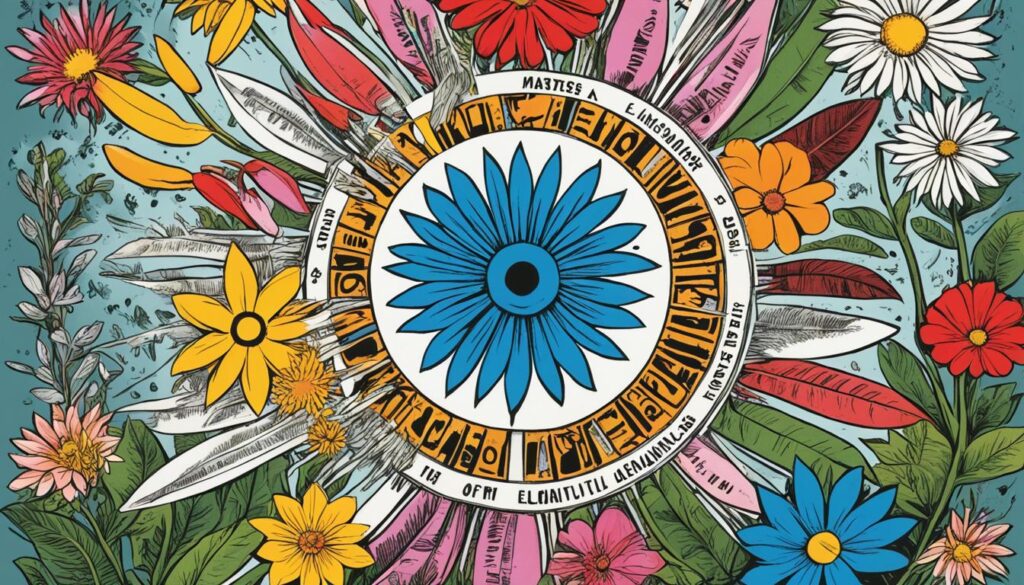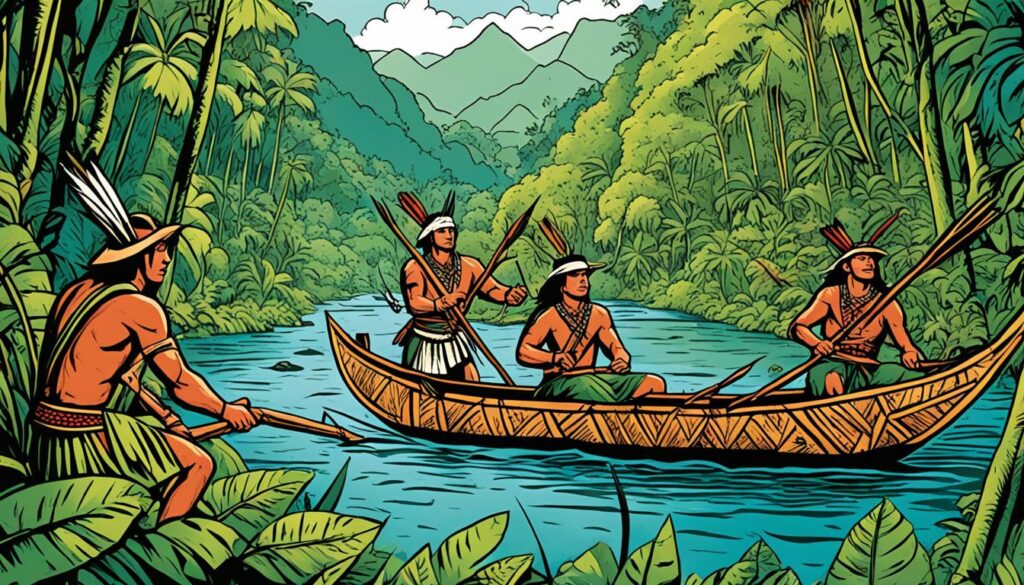Did you know that the Matsés language, spoken by the Matsés tribe in the Amazon regions of Brazil and Peru, is a vibrant linguistic heritage that is crucial to the cultural identity of this indigenous community? With its unique dialects and rich linguistic traditions, the Matsés language plays a vital role in preserving and transmitting the cultural practices, values, and beliefs of the Matsés people.
History of the Matsés People
The Matsés people have a rich and complex history that spans centuries and is intertwined with the indigenous communities of the Amazon region. The tribe, also known as Mayoruna in Brazil, has a unique past shaped by colonization, warfare, and the rubber boom.
For generations, the Matsés tribe had a tradition of warfare, engaging in raids on neighboring indigenous communities. These raids were not only for territorial expansion but also for assimilation purposes. Women and children captured during these raids were assimilated into Matsés families, merging various indigenous groups into the Matsés community.
The colonization of the Amazon region and the subsequent rubber boom had a significant impact on the Matsés way of life. The influx of non-indigenous settlers, missionaries, and the exploitation of rubber resources brought immense change and disrupted traditional Matsés practices. The tribe was forced to relocate to interfluvial areas, seeking refuge and avoiding conflicts.
The arrival of missionaries in the early 20th century introduced the Matsés people to contact with non-indigenous cultures. This encounter resulted in both conflicts and alliances as the Matsés navigated the changing sociopolitical landscape. The tribe experienced challenges in preserving their livelihood and cultural practices amidst external pressures.
Notable Historical Events
- Colonization of the Amazon region
- Exploitation of rubber resources
- Relocation to interfluvial areas
- Contact with non-indigenous cultures
“The colonization and rubber boom brought immense change and disrupted traditional Matsés practices.” – Matsés Tribe Historian
Despite these challenges, the Matsés people have managed to maintain their cultural identity and unique heritage. Their history serves as a testament to their resilience and adaptability, as they navigate the complexities of a changing world while preserving their ancestral traditions.
Number of Speakers and Level of Endangerment
The Matsés language is spoken by approximately 2,200 Amerindians, primarily in Brazil and Peru. In Brazil, the Matsés population is estimated to be around 1,143 people, while Peru recognizes a population of 1,314 Matsés individuals.
What distinguishes the Matsés community is their commitment to language transmission and cultural continuity. The majority of Matsés families in Brazil identify as monolingual, with children being raised and educated exclusively in the indigenous language.
This dedication to preserving their language and cultural heritage ensures that the Matsés language is not currently considered endangered. Despite external influences, the Matsés population’s strong sense of identity and linguistic pride keeps their language alive.

| Country | Number of Matsés Speakers |
|---|---|
| Brazil | 1,143 |
| Peru | 1,314 |
Health and Education Challenges
The Matsés communities face significant challenges in healthcare and education, which impact their overall well-being and cultural preservation. Access to adequate healthcare resources and proper medical tools is limited, leading to high levels of diseases and deaths among the Matsés population. Prevalent health issues include malaria, worms, tuberculosis, malnutrition, and hepatitis.
Furthermore, there is a lack of organization and distribution of vaccinations and medications, exacerbating the health concerns within the community. This hinders efforts to prevent the spread of diseases and protect the Matsés population.
In terms of education, while there have been initiatives to provide Indigenous teacher training, the availability of Matsés schools is limited. As a result, some children are sent to neighboring towns for education. This poses a risk to cultural transmission and the preservation of the Matsés language, as exposure to external influences may overshadow the traditional knowledge and values passed down through generations.
Efforts should be made to improve healthcare infrastructure, enhance access to vaccinations and medications, and expand the availability of Matsés schools to ensure the overall well-being and cultural continuity of the Matsés community.
Healthcare Challenges:
The lack of access to adequate healthcare resources and proper medical tools
- High levels of diseases and deaths
- Prevalent health issues: malaria, worms, tuberculosis, malnutrition, and hepatitis
- Lack of organization and distribution of vaccinations and medications
Education Challenges:
Limited availability of Matsés schools
- Some children being sent to neighboring towns for education
- Risk to cultural transmission and the preservation of the Matsés language
| Healthcare Challenges | Education Challenges |
|---|---|
|
|
Language Family and Cultural Significance
The Matsés language, belonging to the Pano-Tacanan language family, is a key component of the Matsés cultural practices, traditions, and values. As part of the larger Panoan language family, the Matsés language holds a significant position within the Northern Pano region. Its evolution and usage reflect the unique cultural heritage of the Matsés tribe.
Language serves as a powerful tool for cultural transmission, enabling the Matsés community to preserve and perpetuate their rich traditions and way of life. It is through the Matsés language that a distinct social reality is constructed, encapsulating the collective experiences, beliefs, and worldviews of the community.
The Matsés language forms the foundation upon which cultural practices and customs are built, playing a pivotal role in shaping their identity and fostering a sense of belonging. Through the intricate web of language, the Matsés tribe maintains a strong bond with their ancestors, their land, and the natural world around them.
From knowledge of medicinal plants to traditional rituals and storytelling, the Matsés language preserves the collective wisdom of generations, ensuring the continuity of their cultural heritage. It is a living testament to their resilience, adaptability, and distinctiveness as a people.
“Language is the mirror of culture. It allows us to understand the world as Matsés, to transmit the knowledge of our ancestors, and to keep our cultural identity alive.” – Raoni, Matsés Elder
Language and culture are intricately intertwined, making the preservation of the Matsés language vital for the continued existence and well-being of the Matsés people. Efforts to safeguard and revitalize the Matsés language reinforce the importance of linguistic diversity and the indispensable role of indigenous languages in global cultural heritage.

Language Preservation Efforts
Preserving and revitalizing the Matsés language is a significant endeavor that involves various initiatives aimed at safeguarding this important linguistic heritage. Linguistic and anthropological sources have been instrumental in providing valuable insights into the Matsés language and culture, contributing to the efforts of language preservation.
One key initiative is the provision of Indigenous language training and education. Efforts have been made to provide opportunities for Indigenous community members to receive training in language teaching. By equipping individuals with the necessary skills and knowledge, they can become effective language instructors, ensuring the continued transmission of the Matsés language to future generations.
Another critical step in the preservation of the Matsés language is the establishment of Matsés schools that prioritize Indigenous knowledge, culture, and language. These educational institutions play a vital role in fostering a supportive environment for language learning and cultural revitalization. By integrating Matsés language instruction into the curriculum, these schools promote the use and appreciation of the language among young Matsés individuals.
The cultural revitalization of the Matsés community is closely tied to the preservation of their language. Language carries significant cultural knowledge, traditions, and values that are passed down through generations. By actively engaging in language preservation efforts, the Matsés community strives to ensure the long-term vitality of their cultural practices and identity.
“Language is the foundation of a culture, and through its preservation, we can retain our heritage and reinforce our sense of identity.”
Language preservation initiatives are crucial for the Matsés community, as they contribute to the overall cultural revitalization and sustainable development of the tribe. By valuing and promoting the Matsés language, the community can create a lasting legacy that celebrates their linguistic and cultural diversity.
Indigenous Language Training and Education
The training of Indigenous individuals as language teachers plays a pivotal role in the preservation of the Matsés language. Through targeted programs and workshops, community members are equipped with the skills and knowledge necessary to teach the Matsés language effectively. By nurturing a new generation of language instructors, the Matsés community ensures the continued transmission and vitality of their language.
Matsés Schools: Fostering Language and Culture
The establishment of Matsés schools embodies the commitment to language preservation and cultural revitalization. These educational institutions provide a supportive environment that nurtures the Matsés language, culture, and traditional practices. By integrating Matsés language teaching into the curriculum, these schools empower students to connect with their cultural heritage and embrace their linguistic identity.
| Language Preservation Initiatives | Key Highlights |
|---|---|
| Linguistic and Anthropological Sources | Provide valuable insights into the Matsés language and culture |
| Indigenous Language Training | Equip community members with language teaching skills |
| Matsés Schools | Establish educational institutions that prioritize Matsés language and culture |
The Matsés language provides a profound connection to the vibrant cultural traditions and historical significance of the Matsés tribe. Through language preservation efforts, the Matsés community strengthens their cultural identity, ensuring that future generations can celebrate and embrace their linguistic and cultural heritage.
Matsés Language Resources and Literature
Supporting the preservation and celebration of the Matsés language, numerous resources and literature are available for learners and enthusiasts. Linguistic descriptions and ethnological studies conducted by reputable researchers and organizations, such as the Summer Institute of Linguistics (SIL), provide valuable insights into the grammar, vocabulary, and cultural aspects of the Matsés language.
The Matsés language literature offers a treasure trove of oral traditions, stories, and cultural documentation, which serves as a means to preserve and cherish the richness of the Matsés language and culture. These literary works provide a deeper understanding and appreciation of the Matsés people’s unique heritage.
These language resources and literature serve as essential references for linguistic researchers, language learners, and anyone interested in exploring the depth of Matsés language and its significance to the indigenous community.

Conclusion
The preservation of the Matsés language is of paramount importance to the indigenous Matsés tribe as it safeguards their cultural heritage. Efforts to revitalize and protect the Matsés language are crucial for the continuation of the tribe’s cultural traditions, values, and beliefs. By ensuring that future generations have the opportunity to learn and speak the Matsés language, the tribe can preserve their unique identity and contribute to the revitalization of indigenous cultures as a whole.
Recognizing the significance of indigenous languages, such as Matsés, is essential for honoring and celebrating diverse cultural heritages. Preserving these languages is not only a means of safeguarding linguistic diversity but also a way to acknowledge and respect the profound connection between language and culture. The Matsés language serves as a conduit for passing down ancestral knowledge, stories, and traditions, enabling the tribe to maintain their rich cultural tapestry.
Language revitalization efforts encompass a range of initiatives, including language documentation, teacher training, and community-led language programs. By supporting these endeavors, we can contribute to the preservation and revitalization of indigenous languages like Matsés. These efforts not only empower indigenous communities but also foster cultural diversity and promote social cohesion. It is through embracing and valuing indigenous languages that we can truly honor and protect the richness of our collective human heritage.
FAQ
What is the Matsés language?
The Matsés language, also known as Mayoruna in Brazil, is an indigenous language spoken by the Matsés tribe in the Amazon regions of Brazil and Peru. It is part of the Panoan language family.
How is the Matsés language important to the Matsés tribe?
The Matsés language is a cornerstone of the Matsés culture and is spoken by all age groups within the community. It is vital for maintaining the cultural traditions, values, and beliefs of the tribe.
How many people speak the Matsés language?
Approximately 2,200 Amerindians speak the Matsés language, primarily in Brazil and Peru. The Matsés population in Brazil is estimated to be around 1,143 people, while Peru recognizes a population of 1,314 Matsés individuals.
Is the Matsés language endangered?
The Matsés language is not currently considered endangered, as language transmission and cultural continuity are actively maintained within the community. The majority of Matsés families in Brazil identify as monolingual, with children being raised and educated exclusively in the indigenous language.
What challenges do the Matsés communities face in healthcare and education?
The Matsés communities face challenges in healthcare, including a lack of access to adequate resources, resulting in high levels of diseases and deaths. In terms of education, while efforts have been made to provide Indigenous teacher training, the availability of Matsés schools is limited, posing a risk to cultural transmission and the preservation of the Matsés language.
What is the cultural significance of the Matsés language?
The Matsés language plays a vital role in preserving and transmitting the Matsés cultural practices, traditions, and values. It enables the continuation of their rich cultural heritage and ensures the survival of their unique way of life.
What initiatives are being taken to preserve the Matsés language?
Various initiatives have been undertaken to preserve and revitalize the Matsés language, including Indigenous teacher training and the promotion of Matsés schools that focus on Indigenous knowledge, culture, and language. Linguistic and anthropological sources also provide valuable insights into the Matsés language and culture.
Are there any resources available for the Matsés language?
Yes, there are resources and literature available to support the Matsés language, including linguistic descriptions and anthropological studies conducted by researchers and organizations. The Summer Institute of Linguistics (SIL) has contributed to the study of the Matsés language, providing valuable insights into its grammar, vocabulary, and cultural aspects.
Why is it important to preserve the Matsés language?
The Matsés language is a vital component of the indigenous Matsés tribe’s cultural heritage. Efforts towards language preservation and revitalization play a crucial role in maintaining the cultural traditions, values, and beliefs of the Matsés community. By recognizing and valuing the importance of indigenous languages like Matsés, we can support the preservation and celebration of diverse cultural heritages.
